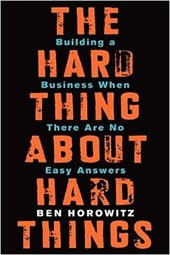In organizational design, as in so many other areas of business management, there are a wealth of books, gurus and industry “best practises” telling entrepreneurs, business owners and HR professionals how they “ought” to create, organize and build their businesses to maximize their chances of success.
In past blogs we have discussed organizational design from many of these perspectives, covering everything from alternative organizational design types and organizing virtual teams, through best practises to the timing and process of reorganizations. Organizational design – creating and communicating the structure that enables businesses to launch, scale and grow, while continuing to innovate – is a huge challenge.
In The Hard Thing About Hard Things: Building A Business When There Are No Easy Answers entrepreneur, venture capitalist and blogger Ben Horowitz shares his insights into the hard things many of these books don’t cover – figuring out solutions for the “challenges that have no recipe” in the complex and dynamic decision environment entrepreneurs face as they “struggle to build something out of nothing”.
 Informed by personal experiences, and curating content shared with millions of readers of his blog over several years, Horowitz provides a self-help guide for leaders, covering everything from dealing with failure “when things fall apart”, through hiring, culture and leadership, to knowing when the time is right to sell and move on.
Informed by personal experiences, and curating content shared with millions of readers of his blog over several years, Horowitz provides a self-help guide for leaders, covering everything from dealing with failure “when things fall apart”, through hiring, culture and leadership, to knowing when the time is right to sell and move on.
His comments about organizational design are illustrative.
His first rule about organizational design is that “all organizational designs are bad”, since any particular design choice made “will optimize communication among some parts of the organization at the expense of the others”.
His second rule, though, acknowledges the necessity of structure, even as the internal and external business dynamics of growth cause growing organizations to “run out of gas”. Organizational designers, in his words, must select the “least of all evils”, recognizing that as you roll out new organizational designs some and perhaps many people in your organization will find fault with them….and “they will be right”.
Achieving a great organizational design in this environment, when you are selecting from the least evil of available options, is a challenge every successful company must confront. The key insight Horowitz offers is to think of organizational design as the communication architecture for your company that will enable both internal and external communication patterns and business possibilities, centered as it must be around the people who “do the work”.
“If you want people to communicate, the best way to accomplish that is to have them report to the same manager. By contrast, the further away people are in the organizational chart, the less they will communicate.”
With this as the framework, he offers a series of basic steps for addressing the hard thing about creating good organizational designs.
- Figure out what needs to be communicated – by listing all of the important knowledge that drives the organization and who needs to have it.
- Figure out what needs to be decided – so that you can put the maximum number of decisions under the domain of designated managers who are empowered to make those decisions.
- Prioritize the most important communications and decision paths – based on the current environment while accepting that it will change.
- Decide who is best suited to run each group – optimizing the organization for the people doing the work, and not for the interests, needs or ambitions of their managers.
- Identify the paths you did not optimize and create contingency plans for them.
As Horowitz notes, “the hard thing isn’t setting up an organization chart. The hard thing is getting people to communicate within the organization you just designed.”
Linking organizational design with communication and transparency makes sense to the Organimi team. Our core mission is to create simple, awesome org charts that help people “Connect. Communicate. Collaborate.” everywhere they work.
With that objective in mind, you may want check out Organimi. Map your current organizational design. Ask yourself what it says about where communications and decision making will go. Think about Horowitz’s ideas on enabling communication and decisions across your organization. See how your current organizational design stacks up, and what “lesser of evils” tweaks you might want to consider to accelerate connections and communication across your teams.
Building sustainable businesses is a challenge. The organizational designs you select can make a difference. Using Organimi to create and evaluate the alternatives as you plan your next organizational design may help.
As always, thanks for reading and checking Organimi out.
The Organimi Team

